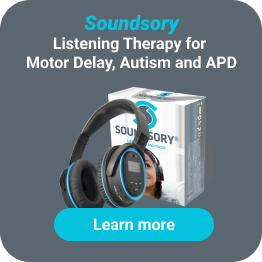Understanding the Key Differences Between Auditory Processing Disorder and ADHD
 Rachel Ann Melegrito
Rachel Ann Melegrito Occupational Therapist
May 17, 2024
Introduction
Does your child zone out often, find it difficult to follow instructions, forget things, and struggle with conversations? If so, they may have attention-deficit hyperactivity disorder (ADHD) or auditory processing disorder (APD). It’s also possible that they have both or have one but are misdiagnosed with the other.
ADHD is a condition that affects the brain’s development and makes it hard for a child to pay attention, focus, and control their behavior. Meanwhile, APD is a condition where the brain finds it hard to make sense of auditory information. This leads to problems with attention, missing out parts of conversations and instructions, and forgetfulness.
While there is an overlap in their symptoms, ADHD and APD are two distinct conditions caused by unique issues in the brain. Getting the right diagnosis is key to ensuring your child receives the proper support and intervention they need.
Read on to understand how these two conditions relate to each other and the key differences that can help you tell them apart.
Key Take-Away Messages
| What are the Differences between Auditory Processing Disorder (APD) and Attention Deficit Hyperactivity Disorder (ADHD)? |
| The main differences between APD and ADHD are related to where and how their symptoms appear: Environment: Children with APD struggle in noisy environments or situations requiring focused listening Consistency: Children with ADHD exhibit consistent symptoms of impulsivity, hyperactivity, and inattention across all environments and situations, regardless of auditory changes. |
Try Soundsory®, a unique blend of music and movement therapy, to enhance your child’s neurodevelopment.
The Relationship Between APD and ADHD
APD, also called central auditory processing disorder (CAPD), is a condition where the brain can’t properly process auditory information, leading to difficulties making sense of sounds and spoken information, particularly when in a noisy environment.
Meanwhile, ADHD is a brain condition that affects how a child thinks and behaves. Children with ADHD have trouble paying attention, tend to be overly active and find it hard to control their impulsive behaviors.
APD symptoms may mimic those of ADHD. Noise around the environment may distract a child with APD and make it hard for them to focus. This can lead to poor academic performance, trouble following and responding to conversations, and a frequent need to ask for things to be repeated. These behaviors might seem like inattention.
Their difficulty in making sense of what they hear also impacts their working memory, a shared struggle with individuals with ADHD [1]. Poor working memory might cause them to miss or forget spoken information, struggle with processing sounds, and possibly “tune out” or shut down due to the fatigue of handling auditory information, behaviors also commonly seen in children with ADHD.
Comparing the symptoms of auditory processing disorder and ADHD can help you see where they overlap and identify symptoms unique to each condition:
| ADHD symptoms [2] | APD symptoms [3] |
| Inattention Easily distracted Forgetful in daily activities Dislikes tasks that require prolonged mental effort Does not follow instructions Does not seem to listen when spoken to Difficulty focusing on task Misses out on details or makes careless mistakes Hyperactivity May talk excessively Unable to play quietly Can’t remain seated when it is expected Impulsivity Interrupts others Problem waiting for their turn Blurts out answers Fidgets or squirms in seat | Experience learning problems Have difficulty paying attention Struggle with distractions Face challenges with reading, spelling, and learning Find it difficult to understand spoken language, especially in noisy environments Frequently ask for repetitions Have trouble following rapid speech Exhibit long delays before responding Find it difficult to follow complex directions Mishear or misunderstand messages Struggle with activities that require listening |
The link between auditory processing disorder and ADHD remains unclear among experts. However, it is widely recognized that sensory processing issues are common in neurodevelopmental disorders like ADHD and autism spectrum disorder (ASD) [4]. In fact, STAR Institute, the leading research center for sensory processing disorder (SPD), reported that nearly half (40%) of children with ADHD also have SPD, with APD as a subtype [5]. This association goes both ways, with APD also being more commonly seen among children with learning difficulties like ADHD, ASD, and dyslexia [6].
It is also possible for a child to have both conditions. According to the American Speech-Language-Hearing Association, APD may co-occur with ADHD and learning and language disorders [3]. A 2011 Egyptian study found that 55% of children with ADHD also had CAPD [7]. Meanwhile, a more recent 2024 Arabian study found that 60% of children with ADHD, particularly those with combined type, also had CAPD [8].
While many suggest that the two are distinct entities, a 2018 systematic review suggested that it’s possible that auditory processing disorder and ADHD, along with other developmental disorders, are related to each other in groups or on a spectrum rather than being truly distinct from each other [9].
How to Differentiate the Two Conditions
APD and ADHD share many symptoms, including poor working memory, forgetfulness, inattention, and easy distractibility. Children with both conditions also perform poorly on intelligence, memory, and language tests, leading to poor academic performance [9].
Despite these similarities, there are significant differences that help distinguish the two conditions. Children with APD can hear sounds and spoken information but have challenges understanding them. Meanwhile, children with ADHD can hear and understand what is said to them but find it hard to focus or attend to them, especially when they are not interested [8].
The situation and environment are also essential factors. Individuals with APD mainly struggle in situations where they have to listen. They have a hard time in noisy environments but perform fine in quiet environments. In contrast, individuals with ADHD exhibit symptoms like inattention and distractibility in any environment. They have problems staying focused not only when they have to listen but also in other situations, like performing self-care or doing their homework.
Executive functions like attention, organization, and problem-solving are also affected in both conditions. However, while it is a primary concern among those with ADHD, reports of executive function difficulties are less frequent in children with APD [10]. At the same time, the difficulty in processing and understanding sounds makes it difficult for children with APD to perform higher executive functions.
Children with ADHD also had better language and higher pragmatic skills than those with ADHD with CAPD [8]. This suggests that children with CAPD may have greater challenges in learning and distinguishing speech sounds and interpreting social cues necessary in social interactions.
The primary concerns raised by parents and teachers also differ in children with ADHD and APD. Typically, adults are more concerned about hyperactivity, distractibility, and impulsivity in kids with ADHD. Meanwhile, the most common complaints of parents and teachers of children with APD include [11]:
- Difficulty listening in noisy environments
- Trouble following directions
- Challenges with listening (such as difficulty distinguishing between sounds and words)
- Tendency to mishear information
- Inattention
- Repeated need for clarifications and repetitions
Treatment and Management Strategies
While their symptoms partly overlap, ADHD and APD are two distinct disorders with different management. That said, accurate diagnosis is essential. Specialists typically make a diagnosis after a detailed clinical assessment. In addition to clinical interviews and information gathering, children assessed for APD also undergo a series of auditory processing disorder tests to confirm an APD diagnosis.
Medication is the mainstay treatment for ADHD, while treatment for APD is mainly managed through auditory processing disorder therapies. Below are the treatment options available for the two conditions:
| ADHD Treatment | APD Treatment |
| Medications Individual and family therapy and training Trigeminal nerve stimulation | Therapy (by audiologists, speech therapists, and occupational therapists) Auditory training Environmental modifications (use of assistive hearing technology Modifications with the listening environment Compensation strategies using higher-order skills |
While their management strategies differ, some treatment approaches are effective for both due to their overlapping symptoms, such as those that address working memory, attention, and learning. Both conditions may benefit from environmental modifications and accommodations that make the child’s environment more conducive to learning. For example, hearing assistive technologies such as frequency modulation (FM) systems and remote microphone systems can be especially helpful. These systems allow children to listen to their teacher’s voice directly through earpieces, improving their ability to focus and listen clearly.
Home-based programs like Forbrain® and Soundsory® may also be beneficial for children with ADHD and APD. These programs use technology and proprietary listening devices that stimulate the brain and capitalize on its plasticity. Forbrain® modifies and sends the child’s own voice back, which alerts the brain and improves self-awareness, attention, focus, and memory. Soundsory® integrates music listening with movement-based exercises to stimulate the brain and improve sensory processing.
Tips for Parents and Educators
Some classroom and home strategies that parents and educators can do to help children with auditory processing disorder and ADHD include the following:
- Reduce distractions
- Eliminate sources of background noise or choose quieter locations (e.g., away from air conditioners and aquariums)
- Select seating closer to the teacher
- Establish a routine
- Utilize an organizer for reminders and tasks
- Request accommodations such as breaks and printed handouts
If you’re unsure whether your child has APD or ADHD, here are some common warning signs that appear in both conditions. If you notice multiple signs in your child, it’s a good idea to consult with your healthcare provider for further assessment:
- Difficulty attending to tasks
- Forgetfulness in daily activities
- Easily distracted by external stimuli
- Problems organizing tasks and activities
- Does not seem to listen or respond late when spoken to
- Difficulty following through on conversations
- Frequently asking for clarifications or repetitions
Conclusion
ADHD and APD are distinct disorders that share overlapping symptoms. While they may appear similar, there are unique characteristics that help distinguish one from the other. Correctly identifying which condition your child has is crucial for ensuring they receive the appropriate support and intervention.
FAQ
References
- Lotfi, Y., Mehrkian, S., Moossavi, A., Zadeh, S. F., & Sadjedi, H. (2016). Relation between Working Memory Capacity and Auditory Stream Segregation in Children with Auditory Processing Disorder. Iranian journal of medical sciences, 41(2), 110–117
- Centers for Disease Control and Prevention (CDC). 2023. Symptoms and diagnosis of ADHD.https://www.cdc.gov/ncbddd/adhd/diagnosis.html
- American Speech-Language-Hearing Association (ASHA). Central auditory processing disorder. https://www.asha.org/practice-portal/clinical-topics/central-auditory-processing-disorder/
- Sanz-Cervera, P., Pastor-Cerezuela, G., González-Sala, F., Tárraga-Mínguez, R., & Fernández-Andrés, M. I. (2017). Sensory Processing in Children with Autism Spectrum Disorder and/or Attention Deficit Hyperactivity Disorder in the Home and Classroom Contexts. Frontiers in psychology, 8,1772
- Ochsenbein, M. (n.d.). Is it sensory processing disorder or ADHD? https://sensoryhealth.org/node/1114
- Aristidou I., & Hohman M. (2023). Central Auditory Processing Disorder. StatPearls [Internet]. Treasure Island (FL): StatPearls Publishing
- Effat, S.,Tawfik, S., Hussein, H.,; Azzam, H., & El Eraky, S. (2011). Central auditory processing in attention deficit hyperactivity disorder: an Egyptian Study. Middle East Current Psychiatry 18(4):p 245-252
- Hegazi, M., Khalil, G., Mohamed, S., & Khodeir, M. (2024). Exploring the relation between the central auditory processing functions and language development among Arabic-speaking children with attention deficit hyperactivity disorder. The Egyptian journal of otolaryngology. 40(1)
- de Wit, E., van Dijk, P., Hanekamp, S., Visser-Bochane, Margot I., Steenbergen, Bert., van der Schans, C., Luinge, M. (2018). Same or Different: The overlap between children with auditory processing disorders and children with other developmental disorders: A systematic review. Ear and Hearing 39(1), 1-19
- Taneja, N. (2017). A mini review on differential overview of central auditory processing disorder (CAPD) and attention deficit hyperactivity disorder (ADHD). Otolaryngoly Open J. SE(1), S20-S23
- East Carolina University Speech-Language and Hearing Clinic. (n.d.). Auditory processing disorder. https://communications-disorders.ecu.edu/clinic/our-services/hearing-audiology-services/auditory-processing-disorder/



